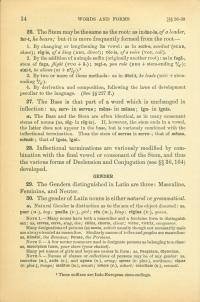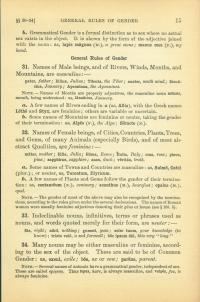29. There are three Genders in Latin: Masculine, Feminine, and Neuter.
30. The gender of Latin nouns is either natural or grammatical.
a. Natural Gender denotes the sex of an object.
puer (m.) boy
puella (f.) girl
rēx (m.) king
rēgīna (f.) queen
Note 1— Many nouns have both a masculine and a feminine form to distinguish sex.
cervus, cerva stag, doe
cliēns, clienta client
victor, victrīx conqueror
Many designations of persons (as nauta sailor) usually, though not necessarily, male are always treated as masculine. Similarly names of tribes and peoples are masculine.
Rōmānī the Romans
Persae the Persians
Note 2— A few neuter nouns are used to designate persons as belonging to a class.
mancipium tuum your slave (your chattel)
Many pet names of girls and boys are neuter in form.
Paegnium, Glycerium
Note 3— Names of classes or collections of persons may be of any gender.
exercitus (m.), aciēs (f.), and agmen (n.) army
operae (f. plur.) workmen
cōpiae (f. plur.) troops
senātus (m.) senate
cohors (f.) cohort
concilium (n.) council
b. Grammatical Gender is a formal distinction as to sex where no actual sex exists in the object. It is shown by the form of the adjective joined with the noun.
lapis māgnus (m.) a great stone
manus mea (f.) my hand


